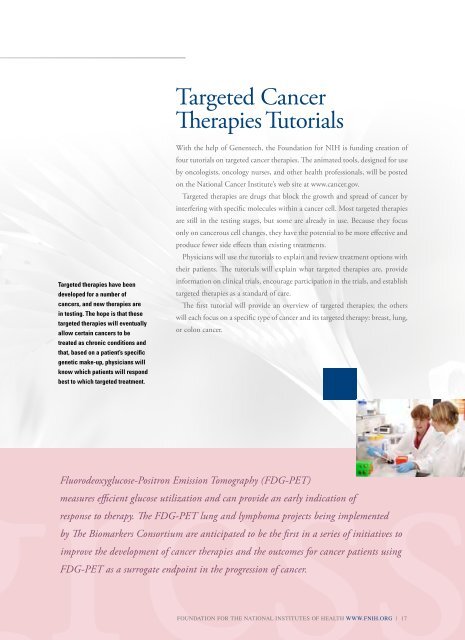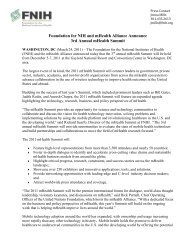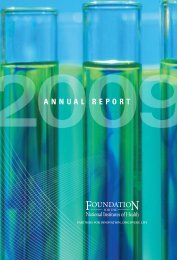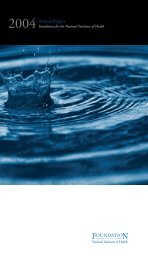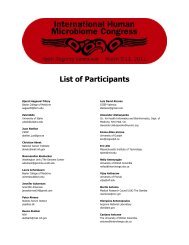2007 Annual Report - Foundation for the National Institutes of Health
2007 Annual Report - Foundation for the National Institutes of Health
2007 Annual Report - Foundation for the National Institutes of Health
Create successful ePaper yourself
Turn your PDF publications into a flip-book with our unique Google optimized e-Paper software.
Targeted Cancer<br />
Therapies Tutorials<br />
Targeted <strong>the</strong>rapies have been<br />
developed <strong>for</strong> a number <strong>of</strong><br />
cancers, and new <strong>the</strong>rapies are<br />
in testing. The hope is that <strong>the</strong>se<br />
targeted <strong>the</strong>rapies will eventually<br />
allow certain cancers to be<br />
treated as chronic conditions and<br />
that, based on a patient’s specific<br />
genetic make-up, physicians will<br />
know which patients will respond<br />
best to which targeted treatment.<br />
With <strong>the</strong> help <strong>of</strong> Genentech, <strong>the</strong> <strong>Foundation</strong> <strong>for</strong> NIH is funding creation <strong>of</strong><br />
four tutorials on targeted cancer <strong>the</strong>rapies. The animated tools, designed <strong>for</strong> use<br />
by oncologists, oncology nurses, and o<strong>the</strong>r health pr<strong>of</strong>essionals, will be posted<br />
on <strong>the</strong> <strong>National</strong> Cancer Institute’s web site at www.cancer.gov.<br />
Targeted <strong>the</strong>rapies are drugs that block <strong>the</strong> growth and spread <strong>of</strong> cancer by<br />
interfering with specific molecules within a cancer cell. Most targeted <strong>the</strong>rapies<br />
are still in <strong>the</strong> testing stages, but some are already in use. Because <strong>the</strong>y focus<br />
only on cancerous cell changes, <strong>the</strong>y have <strong>the</strong> potential to be more effective and<br />
produce fewer side effects than existing treatments.<br />
Physicians will use <strong>the</strong> tutorials to explain and review treatment options with<br />
<strong>the</strong>ir patients. The tutorials will explain what targeted <strong>the</strong>rapies are, provide<br />
in<strong>for</strong>mation on clinical trials, encourage participation in <strong>the</strong> trials, and establish<br />
targeted <strong>the</strong>rapies as a standard <strong>of</strong> care.<br />
The first tutorial will provide an overview <strong>of</strong> targeted <strong>the</strong>rapies; <strong>the</strong> o<strong>the</strong>rs<br />
will each focus on a specific type <strong>of</strong> cancer and its targeted <strong>the</strong>rapy: breast, lung,<br />
or colon cancer.<br />
Fluorodeoxyglucose-Positron Emission Tomography (FDG-PET)<br />
measures efficient glucose utilization and can provide an early indication <strong>of</strong><br />
response to <strong>the</strong>rapy. The FDG-PET lung and lymphoma projects being implemented<br />
by The Biomarkers Consortium are anticipated to be <strong>the</strong> first in a series <strong>of</strong> initiatives to<br />
improve <strong>the</strong> development <strong>of</strong> cancer <strong>the</strong>rapies and <strong>the</strong> outcomes <strong>for</strong> cancer patients using<br />
FDG-PET as a surrogate endpoint in <strong>the</strong> progression <strong>of</strong> cancer.<br />
<strong>Foundation</strong> <strong>for</strong> <strong>the</strong> <strong>National</strong> <strong>Institutes</strong> <strong>of</strong> <strong>Health</strong> www.fnih.org | 17


